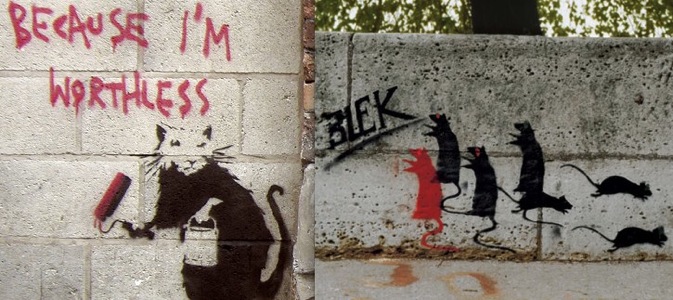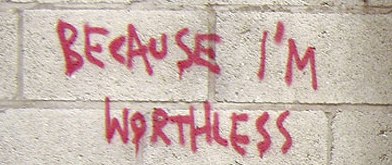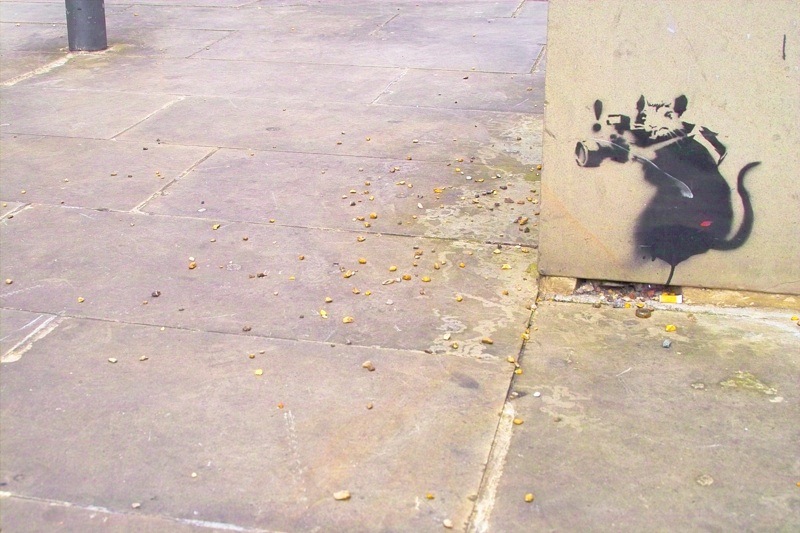Rats

The pioneer of stencil graffiti and Banksy’s predecessor, Blek le Rat, “began to spray rats in the streets of Paris because rats are the only wild living animals in cities and only rats will survive when the human race will have disappeared and died out” (Blek le Rat). The similarities between these nocturnal residents and the graffiti artist are pronounced, both of which are clever, tough, unwanted-vermin of society. Two decades after Blek le Rat invaded Paris with his stenciled rat, Banksy continued the invasion throughout England with the revival of the symbol in the form of social commentary.

Banksy stenciled a black rat holding onto a paint bucket with a paint roller covered in red with the words, BECAUSE IM WORTHLESS, situated above the animal. The writing interpellates the reader: Who is worthless? I am? The rat? The artist? In society, rats thrive in the underworld and that is where they rightfully belong because they represent filth and denote negative connotations. Media reinforces the ideology of the rat as unwanted, creepy rodents that live in sewer pipes. However, the symbol denotes also denotes a positive dual nature of rats: cunning and independent thinkers. In the popular show, Teenage Mutant Ninja Turtles, Splinter is the mutant rat that becomes the adoptive father and sensei of the turtles. At first glance, he appears to be a danger to society, but this gentle giant is there for guidance and wisdom. Most recently, Pixar’s Ratatouille was a story based on a little rat battling an inner struggle of living the typical rat-lifestyle or embarking on his own journey, of which he chose the latter. Far from worthless, the rat stands for immediate reaction, but has an underlying authenticity behind the obvious. Rats, albeit ugly, are undoubtedly smart creatures. They are often the animals of choice for research ranging from psychology to medicine.
Taking this concept, the image of the rat embodies all of Banksy’s belief as a graffiti artist. As the rodent multiplies in retaliation to society’s attempts at pest control, the graffiti underground grows in response to government’s attempts to cleanse the city of street art. Much like the war on drugs, engaging in a war against rats and graffiti is a lose-lose situation; rats regulate themselves to the amount of food available and the will of a deviant artist cannot be caged. Both artist and rat require an amount of stubbornness and wit to sustain a life in a forbidden medium. Besides “rat” being an anagram for art, Bansky uses the rat as a reincarnate art form of himself: to engage in criminal activity in a clandestine manner without detection and detention.

The Worthless rat holds a can of paint, finishing up a tag in red paint. The red, an outstanding color in contrast to the black rat, signifies sin, courage, and warning based on the reader’s “particular knowledge” of cultural history (Rose, 2007). The devil is depicted in iconography and popular culture in red attire and when tempted in the Garden of Eden, Eve ate a red apple that symbolized knowledge. A graffiti artist commits a ‘sin’ every time he acts because he is going against the law. In The Red Badge of Courage, a soldier was presented this badge when he discovered his courage during the American Civil War. Warning denotes caution, such as a STOP sign. The signs are given meaning by the readers that uphold social constructs built to promote order in governing world. The signified are characteristics of a good graffiti artist and Banksy understands that notion. Practicing art with caution takes courage and stealth, which is proven through his track record; he is able to maintain a hidden identity despite the rise in his popularity. In a playful bout of irony, he comments on society’s stereotypical understanding of the worthlessness of the rat, yet uses the rat as himself because of the rat’s endearing qualities.
Self-preservation is key to the rat and graffiti arts alike. As if the rat’s external, gross physique is a façade, people walk around the city owning the town. However, the worthless rat builds his own underground community that grows in numbers every day living amongst a society ruled by humans in which they are looked down upon. Although we are big humans, the sight of a rat calls for a lady to jump on a chair and scream in havoc. As seen in the Disney movie where Princess Cinderella jumps at the site of rat, she reinforces the mythology of damsel in distress. Of which the ideology that a girl should not like rodents, such as rats, and when seen with one will need a ‘Prince’ to rescue her. I can’t count how many times I have seen a rat in the New York City subway system and girls from all ends of the station yelp. Now, are the rats really the worthless ones…or are we?
Home | Foreward | History | Gallery | Afterward | Works Cited
